A Private Tour today in North Norfolk. It was a lovely sunny day, hot but with a nice light breeze just to take the edge off it along the coast. It was the first big tide of the ‘autumn’ season, so with an early start, we headed over to the Wash to look at the waders.
The tide was already starting to come in when we first arrived up on the seawall, but there was still a lot of exposed mud, so we stopped for a scan. Several Ringed Plovers and Oystercatchers were feeding down just below the bank and they were joined by a Dunlin. Some larger flocks of Dunlin were still feeding feverishly out on the other side of the channel, but started to fly further up as the tide began to rise.
One or two Black-tailed Godwits were feeding on the near edge of the channel too, while further out we could see large stains across the mud, big flocks of Oystercatcher, Bar-tailed Godwits and Knot. Gradually all the waders started to move higher up the mud, and a couple of Turnstone flew in past us.
The gulls and terns were gathered away to our right still, but flew in and landed on the mud out in front of us. Amongst the Black-headed Gulls, we could see one or two white-winged Mediterranean Gulls. We got nice views of Sandwich and Little Tern with them too, along with the Common Terns which were flying in and out of the pits behind us carrying food.

It wasn’t long before the mud in front of us was covered by the rising water, so we carried on along the seawall to Rotary Hide, where we stopped to scan again. The Oystercatchers appeared to flow across the mud like a large slick of liquid as they walked up away from the tide, whereas the Knot and the godwits flew across and landed again further from the approaching water.
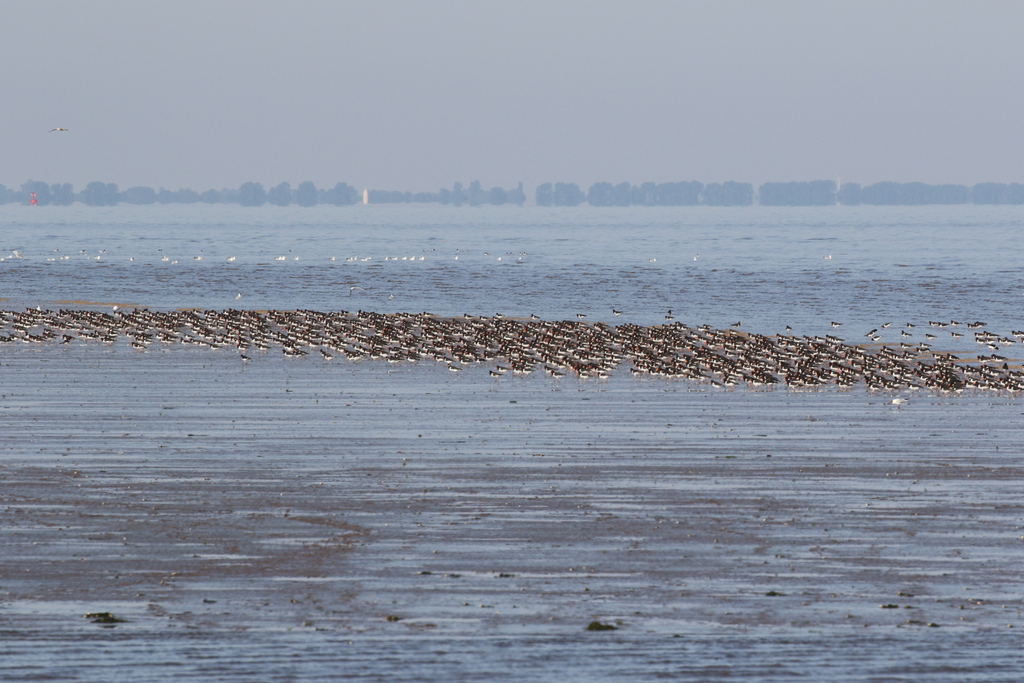
There were lots of Curlew too, gathering on the edge of the vegetation at the back. The Dunlin gave up early today, flying up in a succession of flocks and in over the seawall, flashing their black belly patches, before dropping down onto the pits behind us.
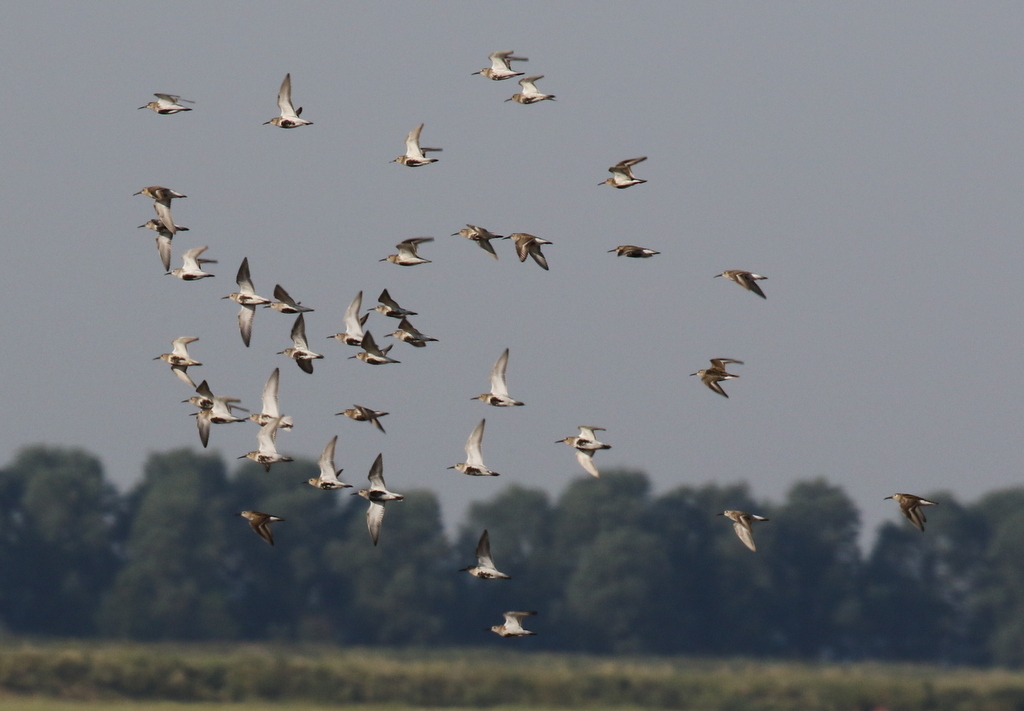
The Oystercatchers were next to start heading in. Rather than flying in one big group, they took off in small flocks and lines, coming in over our heads. There were little groups of Avocets too, passing overhead. We gradually made our way down to the corner, as the tide progressively covered the open mud and the remaining birds were pushed further and further in.
The Knot and the Bar-tailed Godwits resisted longest. Then a Marsh Harrier flew in across the saltmarsh just behind, close enough to spook them. The waders erupted and several large flocks of Knot headed in. All we could hear was the whirring of hundreds of wings as they passed by. The Marsh Harrier was quickly chased off by a zealous Avocet.
Many of the Bar-tailed Godwits landed again and tried to settle in with the Curlews, which were looking to roost out on in the shorter vegetation on the edge of the saltmarsh. Gradually, the rising tide pushed them out again, and we had great views of several large flocks of Bar-tailed Godwits as they flew in overhead. Most were still in bright breeding plumage, with their rusty underparts extending right down under their tails.
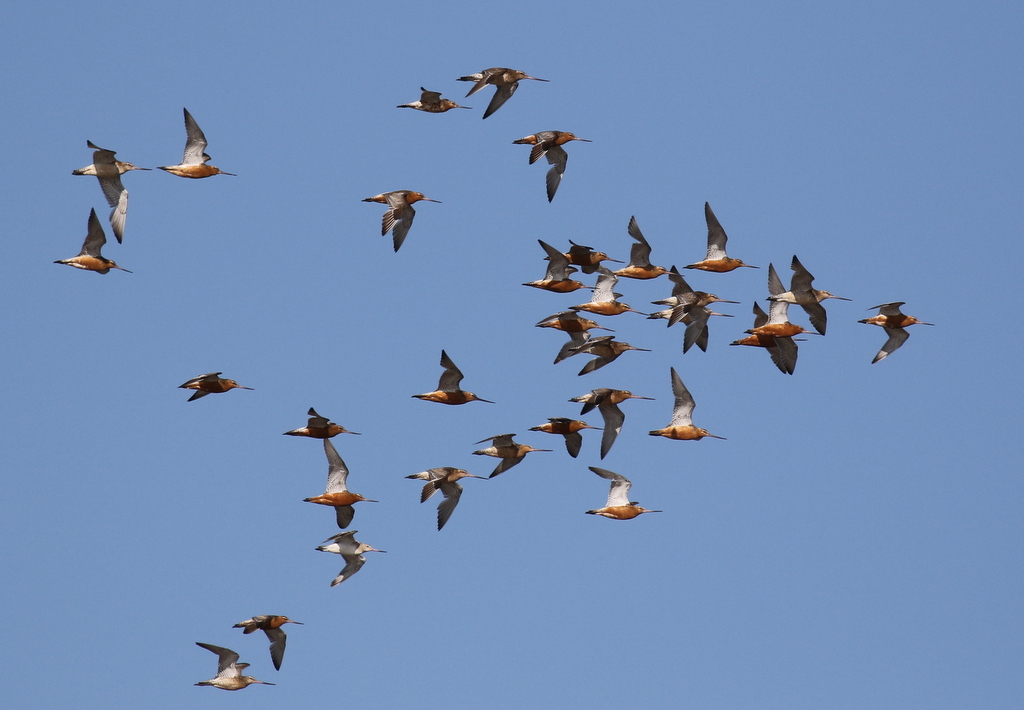
Two Common Sandpipers were disturbed by the rising tide from the near edge of the saltmarsh, just below us, and flew off over the water with flicking wingbeats and bowed wings. A seal surfaced just offshore, presumably looking for fish in the now flooded channels out in the mud. Something spooked all the waders from the pits behind us and they whirled round, flashing alternately dark and light as they twisted and turned. It seemed to be a false alarm though, and they quickly settled back down again.
With most of the waders now pushed in by the tide, we made our way round to the temporary hide round at the south end of the pits to see what we could find there. As we looked out, the islands close to us were covered in waders. Scanning through them, we could see they were predominantly Dunlin, mainly adult birds still in breeding plumage, with black bellies.

In with them, we found several Knot, again mostly in their bright rusty breeding plumage, and Common Redshank. The number of Knot today seemed to be down on what we would normally expect at this time of year – they seem to be slightly late returning from Greenland this year. Still, there was plenty to look at.
The Oystercatchers were all roosting on the shingle bank down along the left. Opposite, on the bank on the other side of the water, were all the Black-tailed Godwits and in with them lots more of the Knot. A Common Sandpiper flew across and landed on its own on an unoccupied area along the gravel edge of the pit, bobbing up and down as it did so.
As we scanned carefully through, we spotted several Spotted Redshanks on the edge of the water below the godwits and Knot. They were already well advanced in their moult, their black breeding plumage already liberally patterned with silvery grey and white feathers, to a greater or lesser degree. We could see their long, needle-fine bills, longer and thinner than the Common Redshanks nearby.
We couldn’t find anything else in with all the waders at this end today, so we made our way round to Shore Hide to have a look from there. There were fewer waders from here, but there were some nice terns on the island right in front of the hide. Several of the Sandwich Terns had scaly-backed juveniles in tow, begging to be fed, and there appeared to be some squabbles between the families. We had a nice view of Common Tern and Sandwich Tern side by side, for comparison.

The tide was slowly starting to recede now, but we decided to move on. We made our way back to the car and round to Titchwell. It was hot now and the trees around the car park were quite quiet. We could hear a Chiffchaff singing and there were some Goldfinches in the bushes. There wasn’t much happening at the feeders by the Visitor Centre so, after a quick look in the sightings book, we headed out onto the reserve.
A Reed Bunting was singing out in the reeds as we walked out. We stopped to scan and found a juvenile Marsh Harrier perched up in one of the small sallows towards the back of the reedbed. Through the scope, we could see it was very dark chocolate brown with a rather gingery orange head. Across the Thornham Grazing Marsh the other side, a Common Buzzard was perched on a post in the distance.
The Thornham Grazing Marsh pool had been bone dry in recent weeks, but has filled up with saltwater after the high tides. This is not part of the reserve and used to be a lovely deep freshwater pool up until a couple of years ago when it was allowed to drain for no apparent reason – it is a complete travesty the way it is being mismanaged by the landowner. There were a few Lapwing, a Curlew and a Grey Heron on here today.
There were lots of ducks out on the reedbed pool, Shoveler, Gadwall, Mallard and one or two Common Pochard too. They are all looking rather drab now, in eclipse plumage. A smart adult Great Crested Grebe sailed out into the middle and a Little Grebe appeared in the channel just beyond. A Common Snipe was busy feeding in the near corner of the Freshmarsh.
We heard Bearded Tits calling, but all we got were several brief flight views as they zipped across over the tops of the reeds before crashing back in out of view. A Reed Warbler was still singing out in the reedbed and we managed to get a look at another which clambered up into the tops of the reeds. The Bearded Tits are often easier to see from Island Hide, so we carried on up to there.
While we kept one eye on the edge of the reeds, we scanned the freshmarsh to see what we could find. There were good numbers of Avocets and Black-tailed Godwits here. A couple of Ruff were feeding on the mud in front of the reeds – we saw lots here today, all moulting males which have moulted out their ornate ruff feathers and are in a bewildering array of colours and patterns.
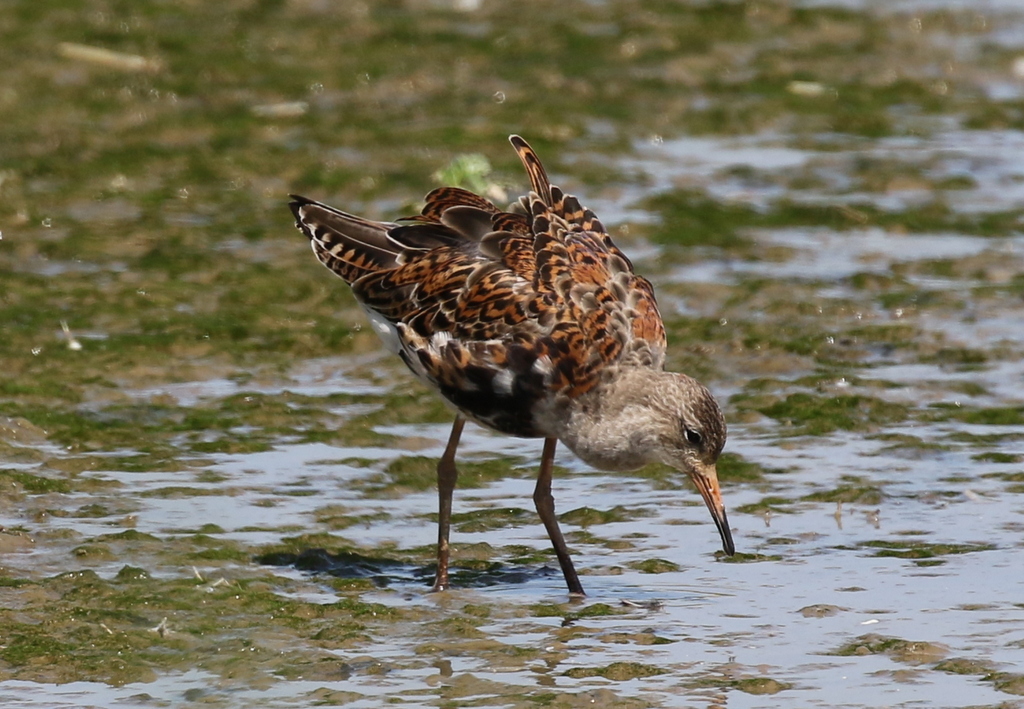
A Little Gull was swimming out on the water here too, circling round and picking at the water’s surface. Despite the lack of any other gulls immediately around, it was noticeably very small, a young bird, a first summer with black feathers still in the wings and a winter-pattern to the head.
There were some Spoonbills on the small island over towards the back of the Freshmarsh too. At first there was only one, doing what Spoonbills like to do best, sleeping. Then, when we looked again more had appeared, presumably from round the back of the island. They started to preen and we could see their spoon-shaped bills.
We could hear Bearded Tits calling periodically and kept looking back at the edge of the reeds. Eventually we managed to get a look at one or two, creeping along low down at the back of the mud. We got a bit of a surprise when we heard ‘pinging’ from right in front of the hide, but the Bearded Tits down here knew just how to keep tantalisingly out of view!
Looking out of the flaps on the other side of Island Hide, we noticed another Ruff on the mud close to us. A second wader walked out next to it and we did a double-take – a Lesser Yellowlegs! This is a rare visitor here from North America, which had been on the reserve three days ago but had not been seen since. As a measure of its rarity here, it was apparently the first ever to have been seen at Titchwell. Where it had been hiding since then nobody knows, but it was a nice surprise to find that it had returned for us!
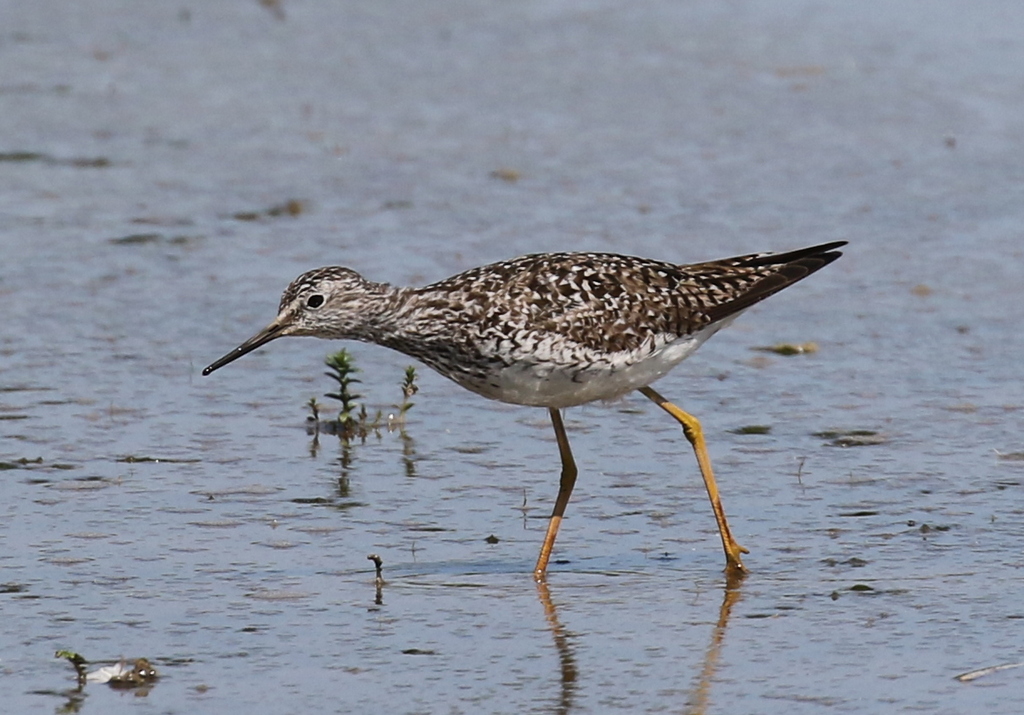
After letting various people know that the Lesser Yellowlegs had reappeared, we set about having a good look at it. It was smaller than the Ruff, with a medium-short, fine bill and long yellow legs (appropriately enough!).
A Common Redshank appeared on the mud nearby and decided to try to chase it off, which gave us a nice chance to see the two species side by side – Lesser Yellowlegs is in many ways the North American equivalent of the Redshank. Again, the Lesser Yellowlegs was noticeably smaller and daintier, as well as their legs being a different colour.
We had a closer look at the Lesser Yellowlegs from up on the main path. Then, as a small crowd started to gather, we decided to move on. Another stop and scan and we noticed a Little Ringed Plover out in the middle of the freshmarsh, but by the time we got the scope on it, it had been disturbed by a couple of Ruff. They can often be found from Parrinder Hide, so we decided to have a look for it from there.
It has been an amazing year for breeding Mediterranean Gulls at Titchwell this year, and there were loads of recently fledged juveniles with scaly backs scattered around the islands in front of Parrinder Hide today. There were plenty of adults loafing here too, and we had a good look at them.
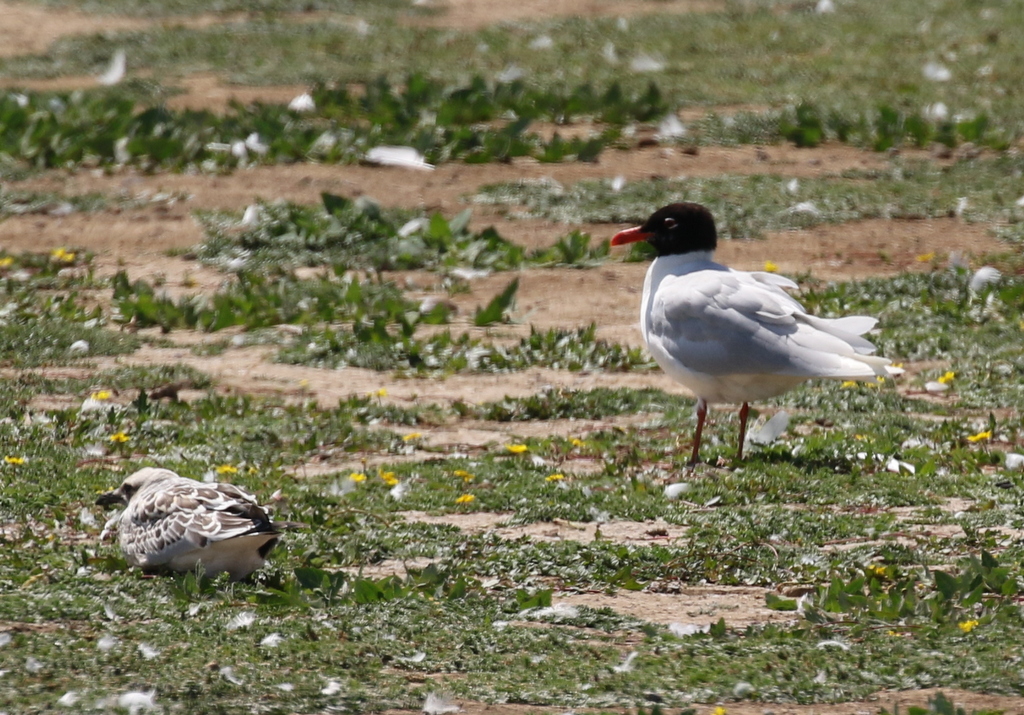
The Little Ringed Plover was feeding on the edge of the mud out of one side of the hide. The bird we first got the scope on was a fairly conventional one – buff-brown, with black and white striped face and golden yellow eye ring. But when we looked back, a much whiter bird had appeared in its place. It was a leucistic Little Ringed Plover, ectensively patterned with pale off white feathers, a rather odd looking washed-out thing. The first Little Ringed Plover then appeared from behind the reeds, just to convince us we hadn’t imagined it!
There were lots of Greylag Geese on the islands in front of the hide, and two Pink-footed Geese walked out to join them. They are both injured birds, most likely shooting casualties, which have been unable to make the journey back up to Iceland for the breeding season, so they have remained here all summer.
Continuing on, out towards the beach, we looked up to see a couple of Wigeon flying over. There was one male which appeared to be over-summering earlier in the year, but it was possible that these two were the first birds we have seen returning from their breeding grounds in Russia. Autumn is definitely upon us, in terms of birds at least! A young Marsh Harrier was quartering back and forth over the Volunteer Marsh, flushing everything.
We stopped to admire a couple of Lapwings feeding on the edge of the muddy channel just below the path. Even though they are moulting and have largely lost their crests, they are still stunning birds. We watched as their glossy green upperparts flashed bronze and purple as they turned in the sunlight.
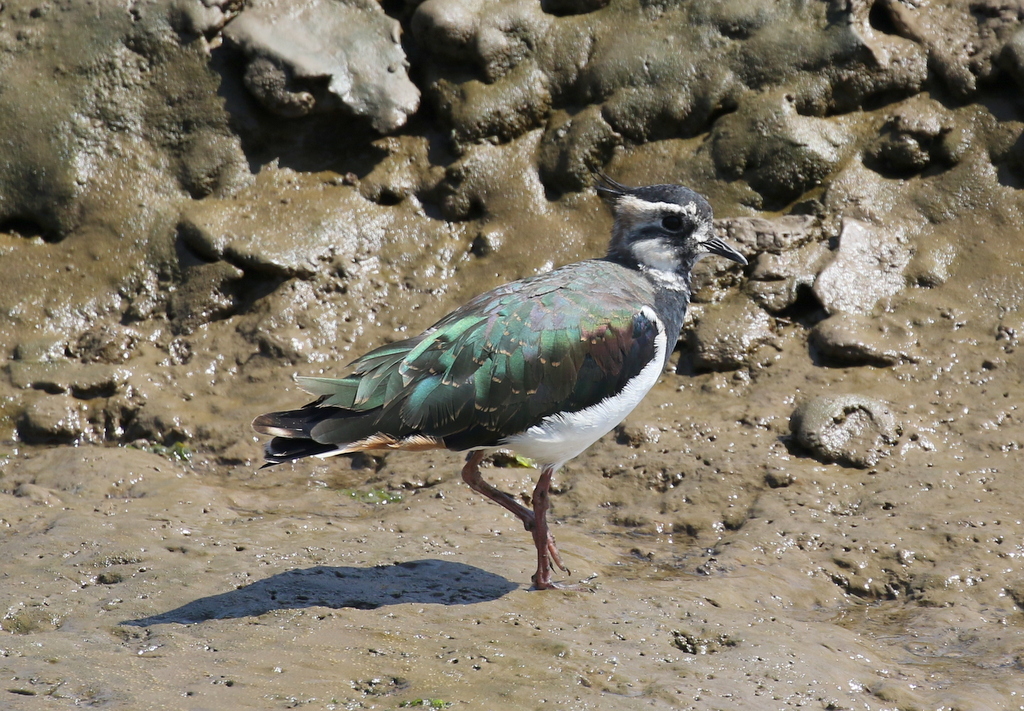
There had apparently been some Greenshank roosting at the back of the Tidal Pools earlier, but they had now disappeared, probably heading off to feed with the tide falling. There were still at least five Spoonbills out here though, as well as 15 Little Egrets. Some of the Spoonbills were asleep, but the two that were awake had rather short bills – juvenile ‘Teaspoonbills’.
The tide had not yet gone out very far when we got to the beach and with several people out enjoying the sand and sea, there were few waders here beyond a group of roosting Oystercatchers with all the Herring Gulls over towards Brancaster. Out to sea, we could see a few Sandwich Terns flying past.
It was getting on for lunchtime, so we set off to walk back. When we got to the reedbed, we looked across to see four Marsh Harriers circling, three dark chocolate juveniles and a grey-winged male. We had just missed a food-pass, the male having brought in from food for the young. We had a great view of the male as it flew towards us and crossed over the path just behind.
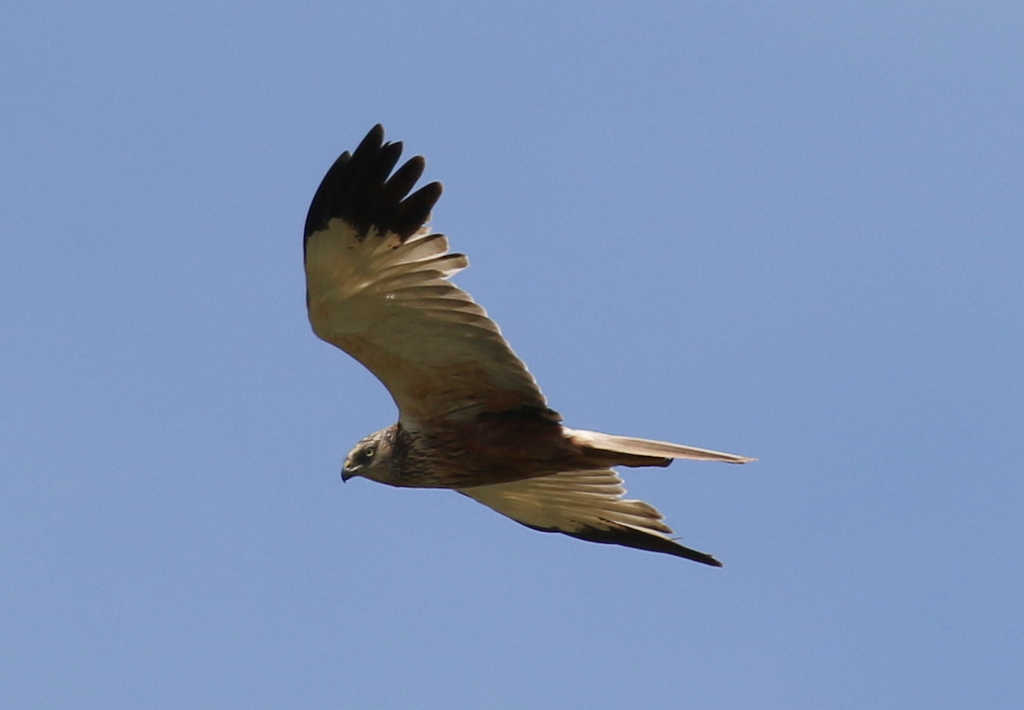
We made our way back to the car and headed off to get some lunch. It was an early finish today, but we had enjoyed a great morning out in the sunshine, action-packed!
















